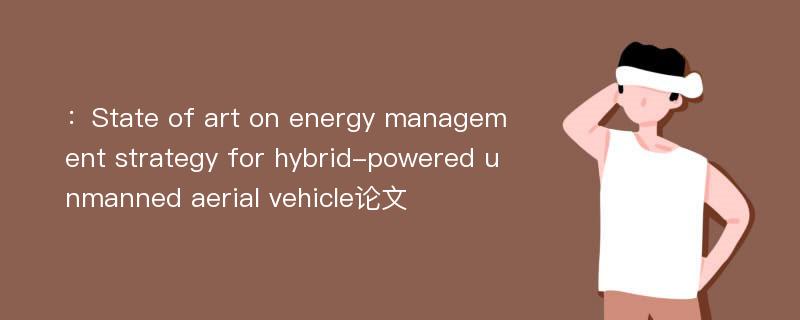
本文主要研究内容
作者(2019)在《State of art on energy management strategy for hybrid-powered unmanned aerial vehicle》一文中研究指出:New energy sources such as solar energy and hydrogen energy have been applied to the Unmanned Aerial Vehicle(UAV), which could be formed as the hybrid power sources due to the requirement of miniaturization, lightweight, and environmental protection issue for UAV. Hybrid electrical propulsion technology has been used in UAV and it further enforces this trend for the evolution to the Hybrid-Powered System(HPS). In order to realize long endurance flight mission and improve the energy efficiency of UAV, many researching works are focused on the Energy Management Strategy(EMS) of the HPS with digital simulation, ground demonstration platforms and a few flight tests for the UAV in recent years. energy management strategy, in which off-line or on-line control algorithms acted as the core part, could optimize dynamic electrical power distribution further and directly affect the efficiency and fuel economy of hybrid-powered system onboard.In order to give the guideline for this emerging technology for UAV, this paper presents a review of the topic highlighting energy optimal management strategies of UAV. The characteristics of typical new energy sources applied in UAV are summarized firstly, and then the classification and analysis of the architecture for hybrid power systems in UAV are presented. In the context of new energy sources and configuration of energy system, a comprehensive comparison and analysis for the state of art of EMS are presented, and the various levels of complexity and accuracy of EMS are considered in terms of real time, computational burden and optimization performance based on the optimal control and operational modes of UAV. Finally, the tendency and challenges of energy management strategy applied to the UAV have been forecasted.
Abstract
New energy sources such as solar energy and hydrogen energy have been applied to the Unmanned Aerial Vehicle(UAV), which could be formed as the hybrid power sources due to the requirement of miniaturization, lightweight, and environmental protection issue for UAV. Hybrid electrical propulsion technology has been used in UAV and it further enforces this trend for the evolution to the Hybrid-Powered System(HPS). In order to realize long endurance flight mission and improve the energy efficiency of UAV, many researching works are focused on the Energy Management Strategy(EMS) of the HPS with digital simulation, ground demonstration platforms and a few flight tests for the UAV in recent years. energy management strategy, in which off-line or on-line control algorithms acted as the core part, could optimize dynamic electrical power distribution further and directly affect the efficiency and fuel economy of hybrid-powered system onboard.In order to give the guideline for this emerging technology for UAV, this paper presents a review of the topic highlighting energy optimal management strategies of UAV. The characteristics of typical new energy sources applied in UAV are summarized firstly, and then the classification and analysis of the architecture for hybrid power systems in UAV are presented. In the context of new energy sources and configuration of energy system, a comprehensive comparison and analysis for the state of art of EMS are presented, and the various levels of complexity and accuracy of EMS are considered in terms of real time, computational burden and optimization performance based on the optimal control and operational modes of UAV. Finally, the tendency and challenges of energy management strategy applied to the UAV have been forecasted.
论文参考文献
论文详细介绍
论文作者分别是来自Chinese Journal of Aeronautics的,发表于刊物Chinese Journal of Aeronautics2019年06期论文,是一篇关于,Chinese Journal of Aeronautics2019年06期论文的文章。本文可供学术参考使用,各位学者可以免费参考阅读下载,文章观点不代表本站观点,资料来自Chinese Journal of Aeronautics2019年06期论文网站,若本站收录的文献无意侵犯了您的著作版权,请联系我们删除。
